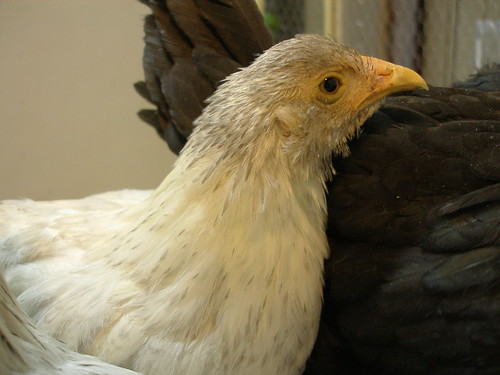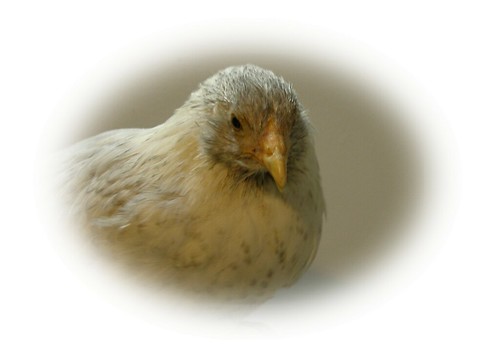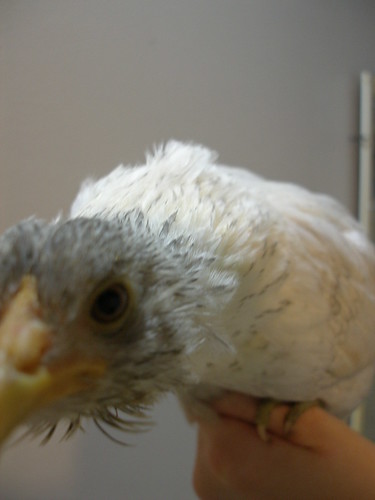Navigation
Install the app
How to install the app on iOS
Follow along with the video below to see how to install our site as a web app on your home screen.
Note: This feature may not be available in some browsers.
More options
You are using an out of date browser. It may not display this or other websites correctly.
You should upgrade or use an alternative browser.
You should upgrade or use an alternative browser.
Really an Ameraucana? or an EE?
- Thread starter Catalina
- Start date
Ameraucanas have slate legs; green legs are usually the sign of an EE. Unless you purchased specifically from a breeder, you can be pretty sure you got an EE.
Sometimes I think we should all start a revolution and demand the hatcheries actually label their birds as what they are. There's nothing wrong with EEs at all; they're often beautiful, friendly birds. Very good layers, sometimes, too. But calling them something they're not (and then putting a little disclaimer somewhere in the fine print) is just trying to trick people. Really. I don't care how the hatcheries try to defend it.
There's nothing wrong with EEs at all; they're often beautiful, friendly birds. Very good layers, sometimes, too. But calling them something they're not (and then putting a little disclaimer somewhere in the fine print) is just trying to trick people. Really. I don't care how the hatcheries try to defend it.
You have a very pretty bird. If you bought from a breeder, she's a bird that *probably* wouldn't be used to breed because of the color of her legs, but she'd still be an Ameraucana. If you bought from a hatchery or a feed store, she's an EE.

Sometimes I think we should all start a revolution and demand the hatcheries actually label their birds as what they are.
 There's nothing wrong with EEs at all; they're often beautiful, friendly birds. Very good layers, sometimes, too. But calling them something they're not (and then putting a little disclaimer somewhere in the fine print) is just trying to trick people. Really. I don't care how the hatcheries try to defend it.
There's nothing wrong with EEs at all; they're often beautiful, friendly birds. Very good layers, sometimes, too. But calling them something they're not (and then putting a little disclaimer somewhere in the fine print) is just trying to trick people. Really. I don't care how the hatcheries try to defend it.You have a very pretty bird. If you bought from a breeder, she's a bird that *probably* wouldn't be used to breed because of the color of her legs, but she'd still be an Ameraucana. If you bought from a hatchery or a feed store, she's an EE.

Pretty sure she's an Easter Egger, but she's very pretty! I agree, Windy, that hatcheries should hold to the 'truth in advertising' rules, particularly in the EE/Ameraucana issue.
i don't get this....
if a silkie has pink skin instead of black, it's still a silkie, just a very very pet quality silkie.
if a wyondotte has a single comb, it's still a wyondotte, just pet quality, and sometimes prized if you are having a bad fertility problem.
if a barred rock has a double barring in his feathers, he's still a barred rock, just pet quality.
and there are many people out there breeding recognized birds to have a certain feather color, which is not recognized by the APA, but the bird is still called that breed of it's mom and dad.
so
why is it that an ameraucana with faults, (wrong color, wrong leg color, wrong egg color, etc etc.) considered an EE instead of a pet quality ameraucana??
i don't get it.

if a silkie has pink skin instead of black, it's still a silkie, just a very very pet quality silkie.
if a wyondotte has a single comb, it's still a wyondotte, just pet quality, and sometimes prized if you are having a bad fertility problem.
if a barred rock has a double barring in his feathers, he's still a barred rock, just pet quality.
and there are many people out there breeding recognized birds to have a certain feather color, which is not recognized by the APA, but the bird is still called that breed of it's mom and dad.
so
why is it that an ameraucana with faults, (wrong color, wrong leg color, wrong egg color, etc etc.) considered an EE instead of a pet quality ameraucana??
i don't get it.

An EE isn't an Ameraucana with faults... it's a "mutt" of uncertain ancestry that may (or may not) carry a gene that causes the hens to lay blue or green eggs.
That's why I made the stipulation that if pretty Lavender was purchased from a breeder, she could be an Ameraucana and just have a fault... a large one, maybe... but she has all the right genes, otherwise. She may pass on the fault, possibly, which is why she probably wouldn't be used in a responsible breeder's program.
However, with EEs, you just don't know what you'll get at all. Some have pea combs (pea combs and blue egg laying are often closely linked), but some have single combs; some lay blue eggs, but some combine that with the trait for brown egg laying and so lay green eggs. Some lay "pink" eggs, which look brown to me.
 They're beautiful birds, though.
They're beautiful birds, though.
However, like a recent thread I saw on here about wanting to create a breed called "Hodoms," EEs don't breed true to type, and you just don't know what you'll get when you cross them.
That's why I made the stipulation that if pretty Lavender was purchased from a breeder, she could be an Ameraucana and just have a fault... a large one, maybe... but she has all the right genes, otherwise. She may pass on the fault, possibly, which is why she probably wouldn't be used in a responsible breeder's program.
However, with EEs, you just don't know what you'll get at all. Some have pea combs (pea combs and blue egg laying are often closely linked), but some have single combs; some lay blue eggs, but some combine that with the trait for brown egg laying and so lay green eggs. Some lay "pink" eggs, which look brown to me.

However, like a recent thread I saw on here about wanting to create a breed called "Hodoms," EEs don't breed true to type, and you just don't know what you'll get when you cross them.
What about a supposedly Americauna rooster, but has yellow legs!
One clue is that people who are selling EEs often misspell "Ameraucana." If Your rooster was sold to you as an "Americauna," you may have been taken.
Not necessarily, though. Some people just can't spell.

Again, I think you're in the same situation Catalina is in. If you purchased from a hatchery, you got an EE. Go back and read the fine print... the text will probably say something like "selected for egg-color" or "not for show"... or the name will be misspelled, or the birds will be sold as "Araucanas/Ameraucanas."
Those are all EEs. If you breed them together, you don't know what you'll get.
This isn't a problem, of course, unless you plan to breed them. If you order your birds from the hatcheries, anyway, it doesn't really matter. And you usually can't show EEs, either, but sometimes you can. Still, if you just want some very pretty girls in a variety of colors that all lay different colors of eggs, I think it would be quite exciting. I've half considered it myself. I bet all the different colors look lovely in a carton.

Not necessarily, though. Some people just can't spell.

Again, I think you're in the same situation Catalina is in. If you purchased from a hatchery, you got an EE. Go back and read the fine print... the text will probably say something like "selected for egg-color" or "not for show"... or the name will be misspelled, or the birds will be sold as "Araucanas/Ameraucanas."
Those are all EEs. If you breed them together, you don't know what you'll get.
This isn't a problem, of course, unless you plan to breed them. If you order your birds from the hatcheries, anyway, it doesn't really matter. And you usually can't show EEs, either, but sometimes you can. Still, if you just want some very pretty girls in a variety of colors that all lay different colors of eggs, I think it would be quite exciting. I've half considered it myself. I bet all the different colors look lovely in a carton.

Jody can answer this more in depth if she comes along since she raises all three breeds and she can correct me if I misstep here. Slate is the only proper color for an Ameraucana's legs. That said, naturally there are true Ameraucanas who are breeder culls, who for some reason do not quite meet the standard on some level, even though they are the true breed. Your bird does not look like one of the colors in the Ameraucana Standard; that plus the off color legs could mean that she is an Easter Egger. Her eyes appear to be the proper reddish bay color, though.
Here is some information on breed standards and below a pic of one of the ones I hatched showing the leg color:
Here is some information on breed standards and below a pic of one of the ones I hatched showing the leg color:
AMERAUCANA LARGE FOWL
Ameraucana large fowl are in the APA All Other Standard Breeds (AOSB) class of chickens. They were admitted to the Standard in 1984. Ameraucana is a general purpose fowl and has a distinctive blue eggshell coloration. Disqualifications include presence of ear tuffs and absence of beard & muffs.
STANDARD WEIGHTS for LARGE FOWL
Cock 6½ lbs. Hen .5½ lbs.
Cockerel .5½ lbs. Pullet ..4½ lbs.
AMERAUCANA VARIETIES (Large Fowl & Bantam)
Black, Blue, Blue Wheaten, Brown Red, Buff, Silver, Wheaten & White
AMERAUCANA SHAPE (Large Fowl & Bantam Males)
COMB: Pea.
BEAK: Curved.
FACE: Nearly hidden by muffs.
EYES: Expressive.
WATTLES: Small, preferably absent.
EARLOBES: Small.
MUFFS AND BEARD: Full, well-rounded, medium length.
HEAD: Medium size.
NECK: Well-arched.
HACKLE: Full.
BACK: Medium length.
SADDLE: Medium in length.
TAIL: Well spread, medium length, carried at 45º above horizontal.
WINGS: Fairly large, tips carried above the hock joint.
BREAST: Prominent.
BODY AND STEARN: Body of medium length, stern well-tucked up.
LEGS AND TOES: Medium length set apart, four toes
AMERAUCANA SHAPE (Large Fowl & Bantam Females)
COMB: Pea.
BEAK: Curved.
FACE: Nearly hidden by muffs.
EYES: Expressive.
WATTLES: Small, preferably absent.
EARLOBES: Small.
MUFFS AND BEARD: Full, well-rounded, medium length.
HEAD: Medium size.
NECK: Medium length.
HACKLE: Full.
BACK: Medium length.
CUSHION: Moderate.
TAIL: Medium length, well spread, carried at 40º angle above horizontal.
WINGS: Fairly prominent, carried above the hock joint.
BREAST: Full.
BODY AND STEARN: Full but trim, fluff well-tucked up.
LEGS AND TOES: Medium length, four toes.

Ameraucana large fowl are in the APA All Other Standard Breeds (AOSB) class of chickens. They were admitted to the Standard in 1984. Ameraucana is a general purpose fowl and has a distinctive blue eggshell coloration. Disqualifications include presence of ear tuffs and absence of beard & muffs.
STANDARD WEIGHTS for LARGE FOWL
Cock 6½ lbs. Hen .5½ lbs.
Cockerel .5½ lbs. Pullet ..4½ lbs.
AMERAUCANA VARIETIES (Large Fowl & Bantam)
Black, Blue, Blue Wheaten, Brown Red, Buff, Silver, Wheaten & White
AMERAUCANA SHAPE (Large Fowl & Bantam Males)
COMB: Pea.
BEAK: Curved.
FACE: Nearly hidden by muffs.
EYES: Expressive.
WATTLES: Small, preferably absent.
EARLOBES: Small.
MUFFS AND BEARD: Full, well-rounded, medium length.
HEAD: Medium size.
NECK: Well-arched.
HACKLE: Full.
BACK: Medium length.
SADDLE: Medium in length.
TAIL: Well spread, medium length, carried at 45º above horizontal.
WINGS: Fairly large, tips carried above the hock joint.
BREAST: Prominent.
BODY AND STEARN: Body of medium length, stern well-tucked up.
LEGS AND TOES: Medium length set apart, four toes
AMERAUCANA SHAPE (Large Fowl & Bantam Females)
COMB: Pea.
BEAK: Curved.
FACE: Nearly hidden by muffs.
EYES: Expressive.
WATTLES: Small, preferably absent.
EARLOBES: Small.
MUFFS AND BEARD: Full, well-rounded, medium length.
HEAD: Medium size.
NECK: Medium length.
HACKLE: Full.
BACK: Medium length.
CUSHION: Moderate.
TAIL: Medium length, well spread, carried at 40º angle above horizontal.
WINGS: Fairly prominent, carried above the hock joint.
BREAST: Full.
BODY AND STEARN: Full but trim, fluff well-tucked up.
LEGS AND TOES: Medium length, four toes.

Thanks for that Cynthia! I don't show (and haven't even bred, yet!) so I sometimes forget how very complicated "type" is.
I know, too, that there are specific standards or ideals for each color variety... lots of ways for a bird to get disqualified from a show standpoint.

Edited to add: Wow! Pretty, pretty blue!
I know, too, that there are specific standards or ideals for each color variety... lots of ways for a bird to get disqualified from a show standpoint.

Edited to add: Wow! Pretty, pretty blue!
Last edited:
You're welcome. And that blue boy is Scout's brother who was purchased by a lady in Alabama along with his other blue brother. He had a huge head, beard, muffs and was a beauty. I almost wish I had kept him and then I could have had splash chicks when bred with my blue pullets. That's okay, the blacks and the blues are just fine.
New posts New threads Active threads
-
Latest posts
-
-
-
-
Is this Bumblefoot healing on its own?
- Latest: Themellowyellows
-
-
-
Latest threads
-
-
Need More Help Please
- Started by FreedomGalTx
- Replies: 0
-
-
-
-
-
Threads with more replies in the last 15 days
-
-
Open Contest Outdoor Garden Show—2025 BYC Summer Fair
- Started by Debbie292d
- Replies: 101
-
Racoon attack; wing torn and toes gone.
- Started by NewBeeChickGurl
- Replies: 96
-
-
Help vets offices closed
- Started by SouthDakotaLiving
- Replies: 71
-
×






